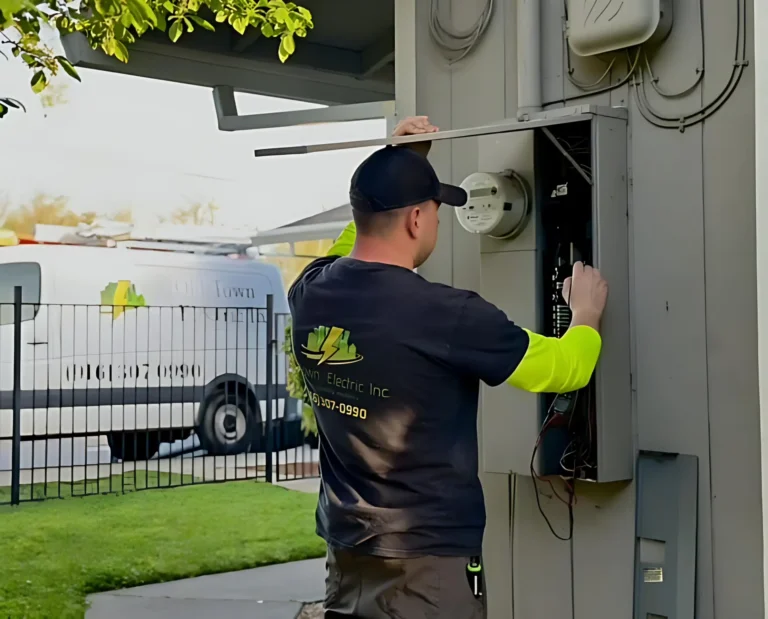If you own a home, chances are you’ve flipped a breaker, swapped out an outlet, or maybe even peeked behind a light switch at some point. That’s when the question comes up: what’s the difference between line vs load wires?
It may sound like a small detail, but in electrical work, getting it wrong can have serious consequences. I’ve seen homeowners blow a brand-new GFCI outlet in minutes simply because they mixed up the two. Truth is, knowing the difference between line vs load isn’t just a technicality, it’s about safety, reliability, and keeping your home’s system up to code.
Table of Contents
What Line Wires Really Do
Let’s start with the basics.
The line wire is the one bringing power in. Think of it as the main highway feeding electricity from the utility into your home’s electrical system. Open up a breaker box in Sacramento on a hot August afternoon, and you’ll see those line wires carrying the current that keeps your AC humming.
In most residential setups:
- Line wires come straight from the panel.
- They carry 120 or 240 volts, depending on the circuit.
- They’re connected to the “line” side of outlets, switches, or devices.
Here’s the thing: line wires are always live. Even if a switch downstream is off, that line is still carrying power. That’s why electricians (myself included) double-check with a voltage tester before touching anything.
Why Load Wires Matter
The load wire is the handoff. It carries power from the device to whatever’s downstream.
For example:
- On a GFCI outlet, the load wire feeds additional outlets further down the line.
- On a switch, the load wire runs from the switch to the light fixture.
What that really means for you: load wires only carry electricity when the upstream device is active. If you’ve ever flipped a switch and watched a ceiling fan roar to life, that was the load wire doing its job.
Line vs Load in Sacramento Homes
Now, let’s bring it closer to home. In Sacramento, many houses were built in the 1970s and 80s, and a lot of wiring has been “updated” by different hands over the years. I’ve opened walls in East Sacramento bungalows where the line and load were mislabeled, and trust me, that caused more than one tripped breaker.
Here are common spots where the difference really matters:
- Bathrooms and kitchens: GFCI outlets depend on correct line vs load connections to protect you from shocks near water.
- Outdoor circuits: Sacramento weather swings, triple-digit heat in July, wet winters, mean outdoor outlets take a beating. Proper line/load wiring ensures protection doesn’t fail when you need it.
- Remodeled spaces: Additions in neighborhoods like Natomas or Elk Grove often have new circuits tied into old ones. That’s where miswiring can creep in.
What Happens If You Get It Wrong
I’ve seen it firsthand. A client in Land Park installed a GFCI outlet in their garage. They reversed line vs load. The outlet seemed fine, until it didn’t trip during a fault. That’s the danger: the protection fails silently.
Common problems when line vs load is swapped:
- GFCI or AFCI outlets won’t protect downstream devices.
- Switches may not cut off power as expected.
- You can end up with constant power on a circuit that should be off.
- Equipment damage or, worse, shock hazards.
Identifying Line vs Load Safely
So, how do you tell which is which?
- Check the labeling. Many modern outlets have “LINE” and “LOAD” stamped clearly.
- Use a voltage tester. With power carefully turned on, test each wire. The line side will always be hot.
- Look at the feed. The wire coming from the panel or breaker is usually line.
- Trace the run. The wire leaving toward other devices is load.
But here’s my honest advice: if you’re not experienced, don’t guess. A wrong call could mean more than just a tripped breaker.
Line vs Load: Why It Matters for Sacramento Homeowners
Let’s be clear. This isn’t just about terminology, it’s about safety.
Sacramento homes face unique challenges:
- Heat waves push air conditioners and fans to their limits, straining wiring.
- Older homes in Midtown may have knob-and-tube or aluminum wiring patched into modern devices.
- Seasonal storms test GFCI and outdoor circuits near patios, pools, and gardens.
Knowing the difference between line vs load is what ensures your protective devices, from GFCIs in bathrooms to AFCIs in bedrooms, actually do their job.
Example: A Midtown Sacramento Remodel
A few years back, I worked on a Craftsman home near McKinley Park. The homeowner had renovated their kitchen but wired the GFCI wrong, line and load flipped. Everything looked fine. But when I tested, the downstream outlets weren’t protected at all.
Imagine cooking near the sink, dropping a plugged-in mixer in the water, and finding out your outlet doesn’t trip. That’s a real risk when line vs load is mixed up. We corrected the wiring, retested, and the homeowner slept a lot easier knowing their family was protected.
How Much Does It Cost to Fix?
People often ask: if I mess this up, what will it cost to fix? In my experience here in Sacramento:
- A simple outlet correction might run $100–$200+
- If multiple outlets or switches are miswired in a remodel, costs climb quickly.
- For peace of mind, a full home safety inspection is often worth it, especially in older neighborhoods.
Compared to the cost of an electrical fire or equipment damage, it’s money well spent.
When to Call a Professional
If you’re replacing a switch or outlet and see both line and load connections, that’s your sign to pause. Sacramento electricians deal with this every day, we have the tools to test, identify, and wire correctly.
Call a pro if:
- You’re installing GFCIs in kitchens, bathrooms, or outdoors.
- You’re not sure which wire is which.
- You’re dealing with older wiring that doesn’t match today’s color codes.
At Old Town Electric, we’ve helped homeowners from Roseville to Elk Grove sort out line vs load issues, often uncovering bigger safety concerns in the process.
Key Takeaways
- Line wires bring power in.
- Load wires carry power out to downstream devices.
- Mixing them up can leave you unprotected or worse, unsafe.
- Sacramento homes, with their mix of old wiring and modern upgrades, are especially prone to miswiring.
If you ask us, understanding line vs load is one of those details every homeowner should at least know about, even if they never plan to touch a screwdriver.
If you’re in Sacramento and unsure about your wiring, don’t take chances. Contact Old Town Electric, your trusted family-owned local electricians. Whether it’s a quick outlet fix, a kitchen remodel, or a full safety inspection, we’ll make sure your line vs load connections are right, and your family is safe.



